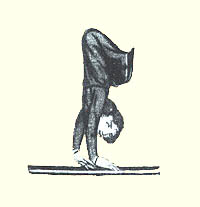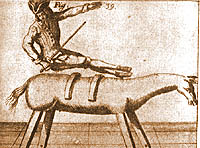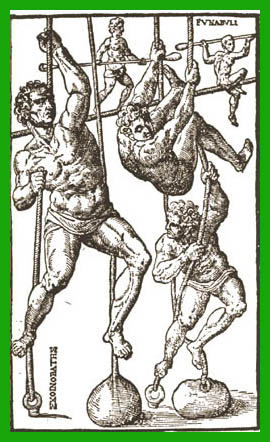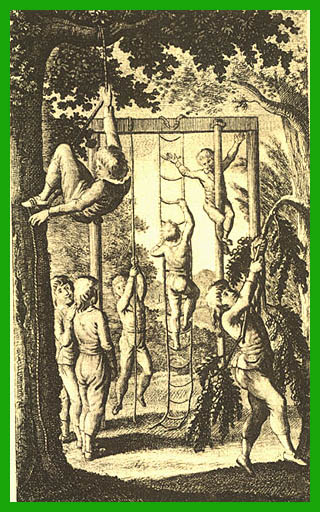 |
Climbing and Gymnastics A Historical Association |
 |
Climbing and Gymnastics A Historical Association |
Climbing Activities in Early Gymnastics . . . "Gymnastic" training exercises similar to, but less refined than those performed by young climbers these days - involving cultivation of the small muscles and tendons of the body, like the fingers, hands, and forearms - were formulated on an ad hoc basis over 110 years ago. Earlier still, what our ancestors called "gymnastics" included several actual climbing activities. The illustrations that follow expose archaic apparatus climbing drills sufficiently close to rock climbing to suggest that gymnastics-inspired rock climbing, usually assumed to have begun in the late 1800s, may have occurred, in undocumented, isolated instances in the late 1700s - if not before. From its inception as the foundation of the physical education movement in the 14th century, gymnastics often included climbing exercises on various pieces of apparatus - ropes, ladders, poles, and masts. As artistic gymnastics assumed center stage during the mid and latter part of the twentieth century these climbing activities gradually disappeared - the last to go being rope climbing for speed, which finally expired during the early 1960s. However, by the 1970s, the first artificial climbing walls had been built, beginning in Europe. And so, ironically, as rock climbing became more gymnastic, gymnastics abandoned climbing! |
| Personalities & Practices . . . Claudius Galen (129AD - 216AD) was a Greek born in Pergamum. He became the most famous doctor of the Roman Empire and is today considered the Father of Sports Medicine. A prolific writer, his references to gymnastic climbing activities - specifically the rope - are among the earliest found. From Gymnastik für die Jugend (1793) by J. F. GutsMuth : "The ancients were not unaware of such gymnastic arts. They called it 'scrambling up the rope' (Greek) or 'ascend by means of ropes' (Latin). According to old documents, the ropes were secured to the ground. Galen mentioned it with the appraisal: 'If anyone climbs a rope with their hands, as children exercise in a gymnasium, they become hard and robust' " - De sanitate tuenda, Lib. II, Cap. 9. (My imperfect translations from the German, Greek, & Latin).  During the age of chivalry (1000 -
1600) boys considered suitable candidates for knighthood were taken
into the households of noblemen as pages. After
several years of training they advanced to squires.
The physical exercises undertaken by squires, included climbing ropes,
poles,
and ladders
(see, e.g., Mirror
of Knights). Of course,
most of their exercises were more closely related to the martial arts
of that time. For instance, at the age of 14 the page had to learn to
leap into the saddle without the help of stirrups - in Saxon law this
was "a
proof of
the ability of a prince to be able to govern independently and
to prove his individual worth" - Gymnastics from the Middle Ages to
the 18th Century by L. H. Joseph, CIBA
Symposia, 1949. During the age of chivalry (1000 -
1600) boys considered suitable candidates for knighthood were taken
into the households of noblemen as pages. After
several years of training they advanced to squires.
The physical exercises undertaken by squires, included climbing ropes,
poles,
and ladders
(see, e.g., Mirror
of Knights). Of course,
most of their exercises were more closely related to the martial arts
of that time. For instance, at the age of 14 the page had to learn to
leap into the saddle without the help of stirrups - in Saxon law this
was "a
proof of
the ability of a prince to be able to govern independently and
to prove his individual worth" - Gymnastics from the Middle Ages to
the 18th Century by L. H. Joseph, CIBA
Symposia, 1949. Rope Dancer ca. 1000AD
 Although the 'sports' of
the nobility centered on the martial arts, hunting, and interestingly,
dancing, they and the other classes of society enjoyed watching
acrobatics - hand balancers and rope dancers, e.g., some of whom
had very shady reputations. (e.g., Acrobats and Mountebanks
by C.
Le Roux, 1890). Although the 'sports' of
the nobility centered on the martial arts, hunting, and interestingly,
dancing, they and the other classes of society enjoyed watching
acrobatics - hand balancers and rope dancers, e.g., some of whom
had very shady reputations. (e.g., Acrobats and Mountebanks
by C.
Le Roux, 1890). 17th century gymnastic vaulting The common people enjoyed participating in sporting events, as well, "The citizens of the towns and the craftsmen exercised on Sundays and holidays during the summer months. In an allegoric poem of Hans Sachs, the shoemaker poet of Nurenburg, Spring boasts to Winter, that during his season people were 'fencing, pushing the stone, and wrestling, hunting, shooting, running and jumping'. In all guild festivals gymnastics were always part of the entertainment" - L. H. Joseph. Among the literature appearing in the latter part of this period, one finds Francois Rabelius (1490-1553) admonishing the young hero of Gargantua (1535) to practice ". . . climbing ropes, masts, trees, and walls . . .". Nine years later, Joachim Camerarius (1500-1574) , in Dialogus de Gymnasiis (1544), describes to a friend his idea of a model school for the common people, in which there is an opportunity for the students to practice indoors, hanging from a bar and climbing ropes.  Hieronymus
Mercurialis (1530-1606) wrote what became, in
his time, a
very popular book describing the "gymnastics of the ancients". He drew
upon ninety-six Greek and Latin authors to reproduce the ancient
gymnasia and gymnastic exercises in De
Arte Gymnastica (1569). From the
illustration on the right, it would
seem that rope climbing
is
indeed a primal gymnastic discipline, although there doesn't seem to be
any mention of it in the easily available literature of the Greek
Games. Incidentally, Mercurialis - a founder of medical gymnastics
- recommended mountain
climbing as a healthful pursuit, due to it's
diaphoretic qualities. He rejected many athletic
exercises for a variety of reasons, considering only rope climbing and wrestling wholesome. "In reality, all
the books on gymnastics of the next centuries are based on this
standard work of Mercurialis" - L. H. Joseph. Hieronymus
Mercurialis (1530-1606) wrote what became, in
his time, a
very popular book describing the "gymnastics of the ancients". He drew
upon ninety-six Greek and Latin authors to reproduce the ancient
gymnasia and gymnastic exercises in De
Arte Gymnastica (1569). From the
illustration on the right, it would
seem that rope climbing
is
indeed a primal gymnastic discipline, although there doesn't seem to be
any mention of it in the easily available literature of the Greek
Games. Incidentally, Mercurialis - a founder of medical gymnastics
- recommended mountain
climbing as a healthful pursuit, due to it's
diaphoretic qualities. He rejected many athletic
exercises for a variety of reasons, considering only rope climbing and wrestling wholesome. "In reality, all
the books on gymnastics of the next centuries are based on this
standard work of Mercurialis" - L. H. Joseph. Greek or Roman Rope Dancers
and Rope Climbers
as illustrated
in De Arte Gymnastica, by Mercurialis, 1569
In the New World, before the 1800s, one can find few references to gymnastic climbing activities, although running and leaping contests were popular pastimes for settlers. In Mexico, however, Fray Diego Duran describes watching an Aztec climbing feat: ". . . to see an Indian standing on top of the 'flying pole' (for so they call it) anywhere between one hundred eighty and two hundred feet in height! He stands there with a trumpet in his hand, and, just watching him, those who observe become giddy . . . after having performed a thousand turns and tricks, he descends with an expression as serene as if he had done nothing!" - The Book of the Gods and Rites and the Ancient Calender, ca. 1577, trans. & ed. by F. Horcasitas and D. heyden, 1971. Johann Friedrich GutsMuths . . . The Grandfather of German Gymnastics  The illustration below depicts one of
the first apparatus created for gymnastics instruction in schools, and
appears in the 1793 book, Gymnastik
für die Jugend, by Johann Friedrich GutsMuths
(1759-1839) - the first textbook of "modern" gymnastics. The climbing frame
was the
model for the climbing apparatus used in many European schools
until, perhaps, the late 19th century. An elaborate and later
version of the frame is on a subsequent page of this section. The illustration below depicts one of
the first apparatus created for gymnastics instruction in schools, and
appears in the 1793 book, Gymnastik
für die Jugend, by Johann Friedrich GutsMuths
(1759-1839) - the first textbook of "modern" gymnastics. The climbing frame
was the
model for the climbing apparatus used in many European schools
until, perhaps, the late 19th century. An elaborate and later
version of the frame is on a subsequent page of this section.  "GutsMuths
took his exercises mainly from the Greek gymnastics, but he also
thought out new movements himself - e.g., heaving exercises on the
sloping beam, climbing pole, rope ladders and climbing ropes, various
balance exercises and exercises on the swinging beam, etc."
-
K. A. Knudsen in A
Textbook of Gymnastics, 1923.
GutsMuths taught at the Academy at Schnepfenthal "GutsMuths
took his exercises mainly from the Greek gymnastics, but he also
thought out new movements himself - e.g., heaving exercises on the
sloping beam, climbing pole, rope ladders and climbing ropes, various
balance exercises and exercises on the swinging beam, etc."
-
K. A. Knudsen in A
Textbook of Gymnastics, 1923.
GutsMuths taught at the Academy at Schnepfenthal"During the summer of 1794, for example, or before it, he [JFGM] has the pupils going up and down a rope ladder, swinging on vertical ropes, climbing a mast, hanging and traveling on the underside of a horizontal beam . . ." - F. E. Leonard in A Guide to the History of Physical Education, 1927 Climbing exercises in GutsMuths' Gymnastics for the Young, 1793 The last paragraph in the chapter on climbing in Gymnastik für die Jugend: "After this and other gymnastic practices that boost the courage of the young person and act as cautious guides, producing both bearing and balance, he will be at home everywhere, and will climb over rocky and wooded outcrops and up rugged hills, without feeling dizzy as he climbs" (my translation) GutsMuths took his pupils on hikes into the countryside regularly. There is a strong likelihood they did some elementary boulder climbing on these excursions. A Calamity . . . ! "One day the young company proceeds to the group of trees to climb the rope and rope ladder there [on the climbing frame]. But see there! Bad rascals from the area have carried away the wooden ladder usually attached there, secured above the crossbeam. Therefore, do we not climb today? We shall climb, nevertheless says the leader, if we can fasten things without the ladder. Ten [students] press forward for this purpose. One considers and begins. The last rung is attached and the rope ladder is slung over his shoulders, and he climbs up the mast . . . So the Gymnast often only gives a signal, and everyone is full of enthusiasm to exert themselves and accept difficulties, which youth never tires of." - Gymnastik für die Jugend Friedrich Ludwig Jahn . . . the Father of German (and Modern) Gymnastics  F.
Jahn (1778-1852) is considered the founder of modern
gymnastics. Although Joachim Camerarius had suggested "hanging from a
bar" in 1544, Jahn is generally given credit for inventing the horizontal bar.
He also invented parallel
bars, which, when added to the wooden vaulting horse
he constructed from a tree trunk in 1812, constitute much of the
apparatus for formal gymnastic competition nowadays. A strong
nationalist, Jahn coined the word Turner
to designate a German gymnast, avoiding the Greek "gymnast". His
outdoor gymnasiums - Turnplatz
- were the
forerunner of modern facilities, and led to the founding of Turnvereins,
which profoundly influenced gymnastic development in both
Europe and America. F.
Jahn (1778-1852) is considered the founder of modern
gymnastics. Although Joachim Camerarius had suggested "hanging from a
bar" in 1544, Jahn is generally given credit for inventing the horizontal bar.
He also invented parallel
bars, which, when added to the wooden vaulting horse
he constructed from a tree trunk in 1812, constitute much of the
apparatus for formal gymnastic competition nowadays. A strong
nationalist, Jahn coined the word Turner
to designate a German gymnast, avoiding the Greek "gymnast". His
outdoor gymnasiums - Turnplatz
- were the
forerunner of modern facilities, and led to the founding of Turnvereins,
which profoundly influenced gymnastic development in both
Europe and America. |

|
| This drawing, from approximately 1811, shows one of the earliest Gymnastics Fields or Turnplatz in Germany. Note the climbing frame on the right side, with an attached oblique ladder. This may have been Jahn's invention. It was essentially GutsMuths' frame, but whereas GutsMuths merely kept a wooden ladder near the frame, in order to climb up and attach the other pieces - using the wooden ladder as an apparatus only when it was placed against a wall - Jahn incorporated the ladder as a piece of apparatus fastened to the frame. It is possible this illustration depicts Jahn's initial version of the famous turnplatz at Hasenheide. |